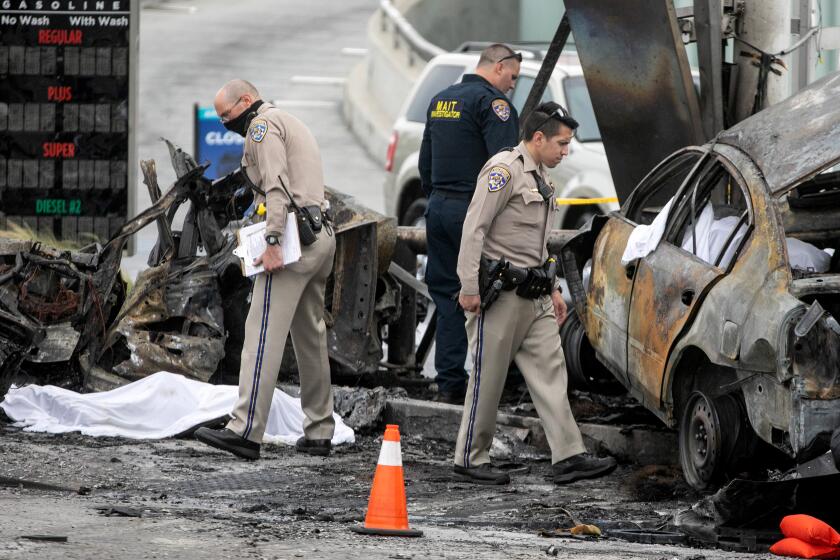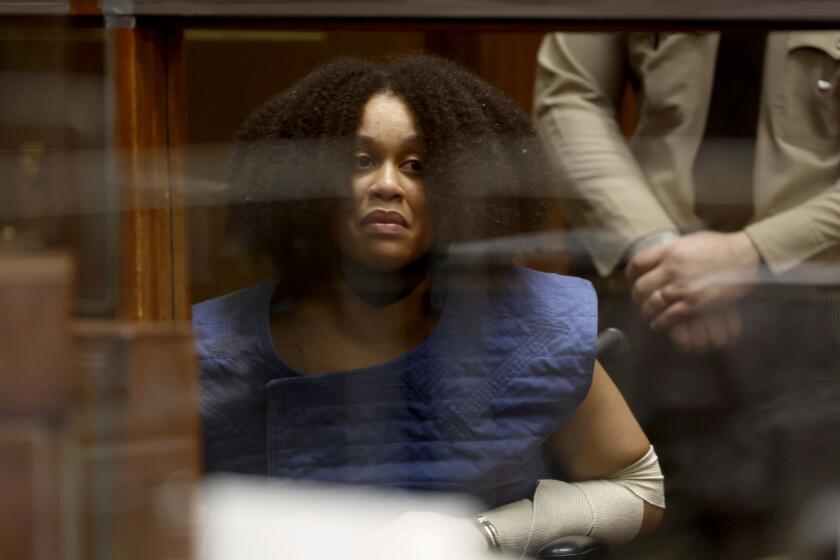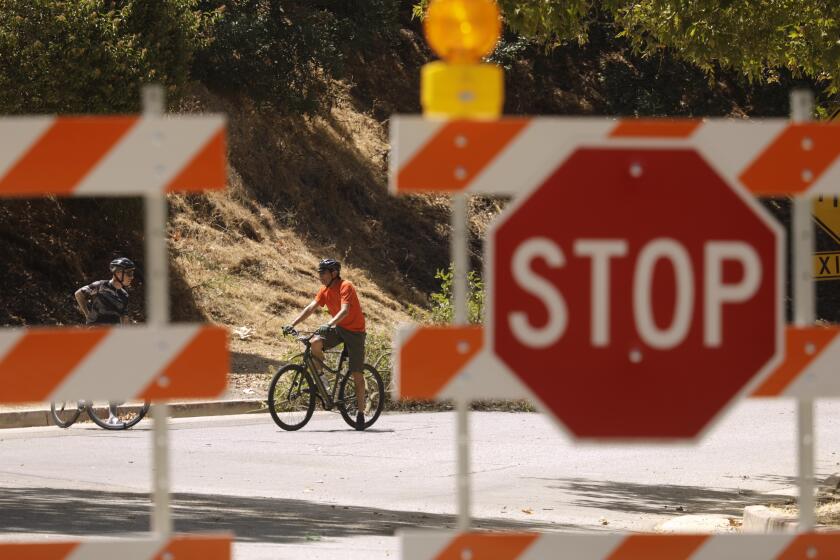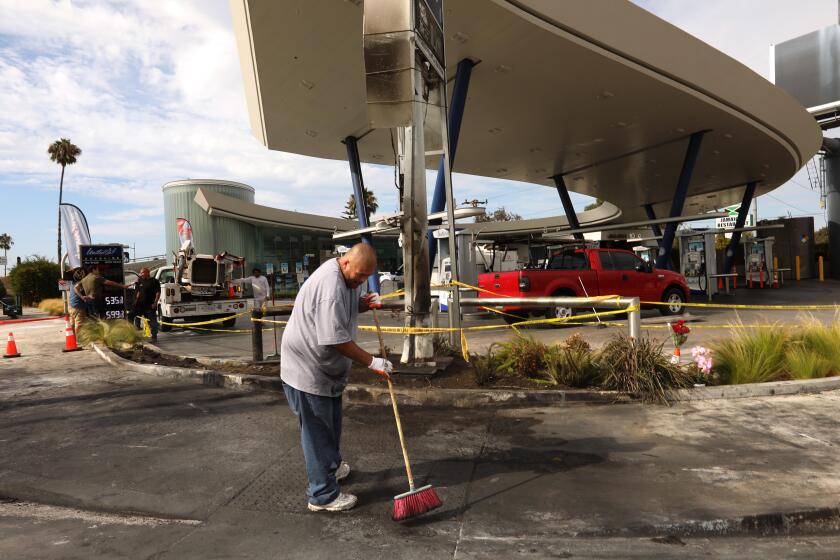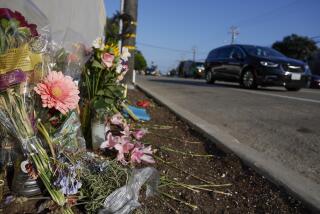Unsafe speeds and reckless driving: Deadly Windsor Hills wreck ‘is the tip of the iceberg’
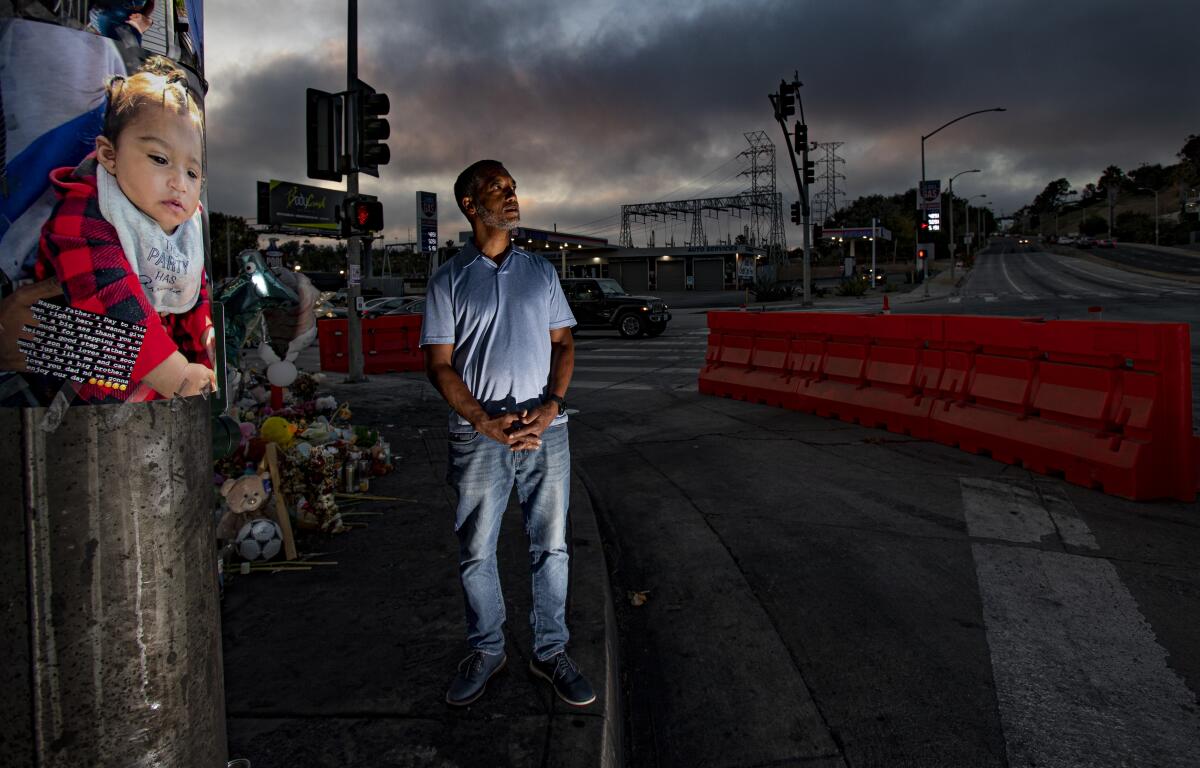
- Share via
Phaedra Battle was just a 19-year-old college student, heading out to watch a new Eddie Murphy movie, when a car slammed into hers at Slauson and La Brea avenues.
More than three decades later, her mother, Francine Battle, 83, watched with a rush of emotion footage of the gruesome Windsor Hills crash that left five people, including a pregnant woman, dead.
The tragedy happened in the same spot where her daughter was fatally injured in 1987.
“They say time heals. It doesn’t,” Battle said. “It is constantly with you, it never leaves you. It might not be as intense, but you never get over the loss.”
The losses are piling up at an alarming rate. With the pandemic came a surge of motor vehicle deaths, abetted by an upswing in reckless behavior. Nearly 43,000 people died in crashes in 2021 — a 10.5% increase from the year before.
And the trend doesn’t show signs of letting up.
A nurse has been arrested on vehicular manslaughter charges in the crash that killed five people, including a pregnant woman, sources confirmed.
An estimated 9,560 people died in crashes in the first three months of this year in the U.S., according to preliminary data released this week by the National Highway Traffic Safety Administration. That’s equivalent to a death every 13 minutes.
“When everyday life came to a halt in March 2020, risky behaviors skyrocketed, and traffic fatalities spiked,” said Steve Cliff, administrator of the NHTSA. “We’d hoped these trends were limited to 2020, but sadly they aren’t.”
Deadly collisions began to shoot up during the pandemic, just as roads emptied out. People who were socially isolated and faced uncertainty became more reckless behind the wheel, speeding and drinking more, data show.
“It’s almost like people forgot common-sense traffic safety rules out there,” said Doug Shoupe, a spokesperson for the American Automobile Assn. “And they, unfortunately, became more risky, not only speeding but distracted driving, engaging in even dangerous driving behaviors like street racing and street takeovers.”
There have been 48 crashes alone at La Brea and Slauson since last year. Speed caused about a third of those collisions. And yet it hasn’t been considered the most deadly intersection in Los Angeles County.
That grim distinction belongs to where Rosecrans Avenue and the 710 Freeway meet; there were seven fatal crashes there between 2011 and 2021, according to state data. A preliminary examination of that data does not reveal how many people died in those crashes.
Authorities say Nicole Lorraine Linton, a 37-year-old registered nurse who had been working at Kaiser Permanente’s West Los Angeles Medical Center, was speeding at more than 90 mph when she careened through a red light at Slauson and slammed into multiple vehicles.
The crash killed pregnant 23-year-old Asherey Ryan and her boy, posthumously named Armani, who was barely a month from his due date. It also killed Ryan’s 11-month-old son, Alonzo Quintero; her boyfriend, Reynold Lester; and best friends Nathesia Lewis, 43, and Lynette Noble, 38.
Friends and colleagues are struggling to come to grips with how the woman they knew as a consummate professional and kind caregiver could be involved in such a horrific chain of events.
For decades, American cities have been building roads to accommodate greater speeds, experts say. Six-lane arterial roads like the one Linton raced through can encourage drivers to blow past speed limits.
Safety experts argue the best way to prevent more traffic deaths is to lower speed limits, redesign roads and use tools like speed cameras to slow drivers down. In some states — such as New York, where officials have been grappling with pedestrian deaths — cameras have been installed. But similar efforts in the California Legislature have failed. And plans to narrow streets often meet strong opposition from drivers who chafe at the notion of a “road diet.”
Jonathan Adkins, executive director of the Governors Highway Safety Assn., said the Windsor Hills crash that took multiple lives might not have been so severe had the road been designed with more impediments toward picking up tremendous speed.
“If there had been a more forgiving infrastructure, this crash may not have been so severe because the speed wouldn’t have been as big of an issue,” he said.
The crash occurred near one of L.A. County’s most affluent Black enclaves, View Park-Windsor Hills. Residents of the largely Black unincorporated neighborhood have long asked for more speed bumps, stoplights and other measures to reduce speeding and unsafe driving.
“If a neighborhood that is financially blessed as we are can’t get the resources to protect our streets, I can’t imagine how other people in South L.A. are feeling and how they can be protected,” said Leon Blum, a View Park-Windsor Hills resident.
Darryl Grayson, president of the area’s United Homeowners Assn. II, put it more bluntly: “They placate us by saying, ‘We are working on it, we are working on it.’ Piecemeal things get done, but nothing near what’s required to save lives. ... This is the tip of the iceberg where Slauson and La Brea happened.”
The rise in fatal crashes during the pandemic surprised academics who expected less traffic to improve safety. But wide-open, relatively empty streets only seemed to encourage speeding and other dangerous behavior.
Activists want to push the city to carve out more street space for cyclists and pedestrians. But many drivers fear more congestion with loss of lanes.
Violations for speeding in excess of 100 mph soared during the pandemic. The first year of COVID-19, the California Highway Patrol nearly doubled from the previous year the amount of tickets it issued. Last year, the number fell but remained far above pre-pandemic levels.
And though fatal crashes may seem random, government statistics tell a different story. Lower-income neighborhoods and communities where people of color live tend to also have more traffic and people traveling at higher speeds. Native Americans and Black people die in higher numbers. The statistics highlight persistent disparities that are playing out across Los Angeles.
Neighbors say Windsor Hills’ Angeles Vista Boulevard has become a cut-through street to get from Crenshaw Boulevard to Slauson Avenue. A broad, palm-lined thoroughfare, it’s also one of the hilly neighborhood’s main arteries. Takeovers, street racing and games of chicken occur regularly, residents say, and it has spilled out into surrounding streets.
“People are frightened. I’ve heard people talk about post-traumatic stress syndrome just from driving down Slauson and La Brea,” Grayson said.
Two years ago, a speeding car crashed into a preschool not far from the intersection. The car struck the gate of the Center for Enriched Education and landed in a classroom where children under 5 are usually napping or in circle time. Fortunately, the school was on winter break.
“It’s not like this incident is the first incident. This has been going on for years, yet nothing has been done,” said Pamela Wiley, the school’s owner.
L.A. County Supervisor Holly Mitchell represents the area along with Compton, Gardena, Culver City, Hawthorne and El Segundo. Her district has the highest rates of vehicle fatalities in Los Angeles County; 749 people died in collisions last year.
Mitchell, who took over her seat just as the pandemic was starting, said one of the first calls she got from a constituent was about traffic safety. In Windsor Hills, she has been working with the county’s Department of Public Works on 20 specific requests to add in speed bumps and do other things to reduce the danger. She expects many of the measures to be in place by the end of the year.
Could better street design -- fewer traffic lanes, more protection for cyclists, dedicated bus lanes -- have prevented the Windsor Hills crash?
Mitchell is also working to prioritize intersections and other locations to address traffic safety.
Offer Grembek, a safety researcher at UC Berkeley, said U.S. infrastructure was built for cars to get to places quickly. Speeds weren’t set to prevent people from dying. Drivers largely set the speeds on most streets under rules that base speed limits on the flow of traffic. And the whole infrastructure relied on the notion that people would follow the rules.
“The strategy has proven not too effective. And it has positioned the U.S. probably two or three decades behind in terms of traffic safety behind many of the European countries that went the other way,” he said.
Nancy Munoz said she proudly moved into her three-bedroom Tudor-style house on Angeles Vista Boulevard in View Park-Windsor Hills nine years ago. Three weeks later, as she was making dinner in her kitchen, a loud screech startled her.
“The sound of the impact. It was a dull, strong sound. I know it in my sleep,” said the 53-year-old nurse.
A speeding driver had lost control and careened into the palm tree in front of her house.
Neighbors rushed out, she recalled: “They told me this is the way we meet each other around here. This happens all the time.”
Since then, she has seen at least 10 accidents within two blocks of her home, including one in 2017 in which a driver slammed his two-door Mercedes into a tree.
His screams awoke Munoz. He was trapped inside the burning car. Harried neighbors tried to free him, but the flames engulfed the vehicle and he died.
The charred palm tree is still standing, and Munoz now leaves a fire extinguisher by the front door — just in case.
More to Read
Sign up for Essential California
The most important California stories and recommendations in your inbox every morning.
You may occasionally receive promotional content from the Los Angeles Times.

